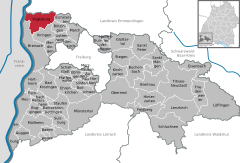Vogtsburg im Kaiserstuhl
| Vogtsburg | ||
|---|---|---|
|
||
| Coordinates: 48°05′21″N 07°37′54″E / 48.08917°N 7.63167°ECoordinates: 48°05′21″N 07°37′54″E / 48.08917°N 7.63167°E | ||
| Country | Germany | |
| State | Baden-Württemberg | |
| Admin. region | Freiburg | |
| District | Breisgau-Hochschwarzwald | |
| Government | ||
| • Mayor | Benjamin Bohn | |
| Area | ||
| • Total | 37.40 km2 (14.44 sq mi) | |
| Population (2015-12-31) | ||
| • Total | 5,888 | |
| • Density | 160/km2 (410/sq mi) | |
| Time zone | CET/CEST (UTC+1/+2) | |
| Postal codes | 79235 | |
| Dialling codes | 07662 | |
| Vehicle registration | FR | |
| Website | www.vogtsburg.de | |
Vogtsburg im Kaiserstuhl is a town in the Kaiserstuhl, a volcanic region in the district Breisgau-Hochschwarzwald, Baden-Württemberg. It has a population of about 5,700 and was created on January 1, 1975 through the unification of seven smaller villages. With its 5.4 square miles (14 km2) of vineyards, Vogtsburg is the biggest wine producing town in Germany.
The individual villages of Vogtsburg are embedded in the valleys of the inner Kaiserstuhl (except Burkheim). The horseshoe-shaped mountain range of the Kaiserstuhl opens to the west and forms the border of the area of Vogtsburg. To the west Vogtsburg borders the Rhine and the French region of Elsass.
The relatively low height above sea level and the protected position between the Vosges Mountains and the Schwarzwald (the Black Forest) create a nearly Mediterranean microclimate.
The mountains of the Kaiserstuhl are a later result of the creation of a great rift (the Rhine Rift) followed by some smaller volcanic activity. The Kaiserstuhl consists of thick layers of loess (100 ft (30 m)), which, together with the special climate, is the main reason for the extraordinary fertility of this area.
Although the city of Vogtsburg is one of the youngest in Germany, the individual villages making it up are mostly more than 1000 years old. The earliest archaeological finds in the village Oberbergen date to the times of the Linear Pottery culture during the Paleolithic era between 4000 and 2500 BC.
Archaeological finds in Bischoffingen give evidence of neolithic settlers of the Corded Ware culture. Other archeological excavations found flexed burials, which could be dated to the Bronze Age between 1700 and 1200 BC. In more recent history, from 800 BC onwards, there is extensive evidence of Celtic occupation. With the arrival of the Alemanni around 200 AD the Celts seem to have disappeared from the region. The area of Oberbergen is considered to be the most important settlement in South Baden during the era of the Hallstatt culture.
...
Wikipedia




